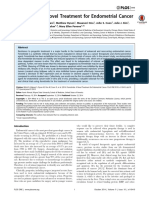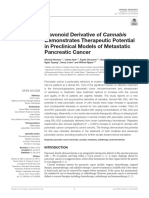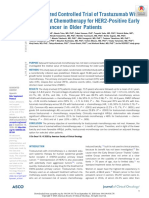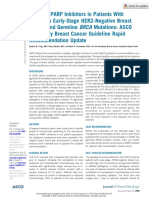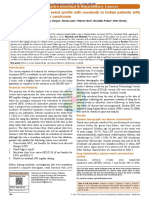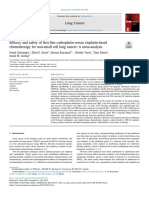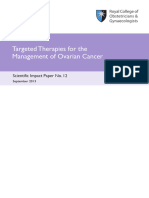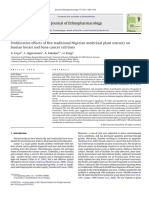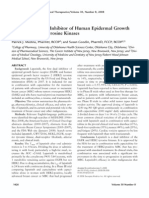Professional Documents
Culture Documents
PARP (Poly (ADP) - Ribose Polymerase) Inhibitors - Application of Synthetic Lethality Concepts in Cancer Treatments
Original Title
Copyright
Available Formats
Share this document
Did you find this document useful?
Is this content inappropriate?
Report this DocumentCopyright:
Available Formats
PARP (Poly (ADP) - Ribose Polymerase) Inhibitors - Application of Synthetic Lethality Concepts in Cancer Treatments
Copyright:
Available Formats
Volume 6, Issue 2, February – 2021 International Journal of Innovative Science and Research Technology
ISSN No:-2456-2165
PARP (poly (ADP)-ribose polymerase) Inhibitors –
Application of Synthetic Lethality Concepts in
Cancer Treatments
Michael Halim* 1
1
University of Salford, MSc Biomedical Science, Greater Manchester, United Kingdom
Abstract:- The different types and the overwhelming cancer treatment, researchers observed a lower response rate
number of cancer cases across the globe have prompted in patients who had previous exposure with conventional
scholars to pursue more effective therapies than therapy based on platinum (Litton, et al., 2018). Patients
traditional treatments. One approach that has from the EMBRACA clinical trials indicate higher QoL,
demonstrated considerable progress is related to the use PFS and OS after the intervention in comparison to those
of PARP inhibitors. Essentially, PARP inhibitors such as receiving standard platinum therapy (Shen, et al.,
Talazoparib, Olaparib and Rucaparib use a concept of 2013).Specifically, interim analysis from the EMRACA
synthetic lethality to kill tumour cells. According to clinical trials recorded an Overall Survival of 22.3 months in
Sebastian (2011) synthetic lethality occurs when a comparison to 19.5 months from standard chemotherapy
deficiency in one gene expression does not cause cell (Exman, et al., 2019). The Overall Survival Rate is yet to be
death while a collection of two or more deficiencies in determined from ongoing research since Talazoparib is a
gene expression leads to cell death. PARP inhibitors relatively novel drug only approved in 16th October, 2018
exploit this concept to eradicate tumour cells. (Exman, et al., 2019). Side effects of Talazoparib include
nausea, fatigue and anaemia (Litton, et al., 2018).
Keywords:- PARP Inhibitors, Talazoparib, Olaparib,
Rucaparib. Olaparib
Olaparib has been studied in different types of cancer.
I. INTRODUCTION Well known clinical trials generating knowledge on the drug
are the NRG Oncology trial and the PAOLA-1 trials (Oza,
In detail, normal and cancer cells undergo constant et al., 2015). The drug is effective at treating refractory
DNA damage due to environmental hazards and other ovarian cancer, breast cancer and Oviduct cancer (Institute
molecular toxics. Normal cells repair DNA damage through of Cancer Research, 2019). In contrast to Talazoparib,
two pathways; (1)PARP which is primed for repairing single Olaparib can be used efficiently in conjunction with other
strands and ; (2) BRCA1/2 that repairs double strands cancer therapies (Washington, et al., 2019). Research
(Sebastian, 2011; Litton, et al., 2018). By contrast, a cancer indicates that Olaparib is effective at eliminating targeted
cell with deficiencies in BRCA1 and BRCA2 gene tumour cells; however, cancer may relapse after a while
expression only has the PARP pathway to repair DNA usually less than three years (Institute of Cancer Research,
damage (Sebastian, 2011). Therefore, introducing PARP 2019). Olaparib has had successful outcomes as a
inhibitors such Talazoparib, Olaparib and Rucaparib make it maintenance drug for patients suffering from Ovarian
impossible to repair DNA damage in tumour cells thus, cancer. As of 2016 and with 79% maturity data, Olaparib
leading to further damage ending in cell death (Sebastian, recorded an Overall Survival Rate of 75% (European
2011; Litton, et al., 2018). PARP inhibitors do not kill Society For Medical Oncology, 2018). Even so Olaparib is
normal cells as they still have the BRCA1/2 pathways to relatively ineffective in other scenarios for instance,
repair DNA (Litton, et al., 2018). Robson, et al.(2019) observed that there was no
improvement in the Overall Survival rate for patients with
II. RESULTS AND DISCUSSION metastatic breast cancer. Patients who undergo treatment
with Olaparib experience side effects such as nausea,
Talazoparib fatigue, heartburn and constipation (European Society For
One of the most common cancer therapies based on Medical Oncology, 2018).
PARP inhibitors is Talazoparib which is used to treat breast
cancer (Exman, et al., 2019; Litton, et al., 2018). From the Rucaparib
EMBRACA clinical trials, Talazoparib is a more potent Rucaparib is a PARP inhibitor used to treat advanced
treatment than conventional cancer therapy based on ovarian cancer and endometrial cancer (Shirley, 2019). In
platinum (Litton, et al., 2018). Notably, Talazoparib, the ARIEL-2 trial, researchers emphasized the role of
Olaparib and Rucaparib work solely in patients with Rucaparib as maintenance therapy (Yvette Drew, et al.,
mutations in BRCA1/2 which impedes homologous 2019). Specifically, Rucaparib is an approved therapy for
recombination (Exman, et al., 2019). Even though women with ovarian cancer who have undergone more than
Talazoparib is considered more effective than standard two chemotherapies (Molin, et al., 2018). From studies, the
IJISRT21FEB502 www.ijisrt.com 734
Volume 6, Issue 2, February – 2021 International Journal of Innovative Science and Research Technology
ISSN No:-2456-2165
drug has different degrees of outcomes depending on the [7]. Robson, M. E. et al., 2019. OlympiAD final overall
presence of LOH (loss of heterozygosity) which is the survival and tolerability results: Olaparib versus
subsequent loss of a gene and the chromosomal region [8]. chemotherapy treatment of physician’s choice in
surrounding the gene or the existence BRCA gene mutations patients with a germline BRCA mutation and HER2-
(Molin, et al., 2018). Data on the efficacy of Rucaparib is negative metastatic breast cancer. Annals of Oncology,
still being collected and is not mature to be used in the 30(4).
calculation of the overall survival rate (Molin, et al., [9]. Sebastian, N., 2011. "Synthetic Lethality: General
2018).Nevertheless, the overall rate of response (ORR) of principles, utility and detection using genetic screens
Rucaparib in ARIEL 3 patients with BRCA1/2 mutations is in human cells". FEBS Lett, 3 Jan, Volume 585 (1), p.
38% which is significantly higher than placebo at 9%. 1–6.
Notably, clinical trials indicate that the Rucaparib may [10]. Shen, Y. et al., 2013. BMN 673, a novel and highly
display “off-target effects” when interacting with PARP1 potent PARP1/2 inhibitor for the treatment of human
and PARP2 (Molin, et al., 2018) The most common side- cancers with DNA repair deficiency. Clin Cancer Res,
effects after treatment with the drug are fatigue (69%), 19 (18), p. 5003–5015.
nausea (75%), constipation and vomiting (Molin, et al., [11]. Shirley, M., 2019. Rucaparib: A Review in Ovarian
2018; Yvette Drew, et al., 2019). Cancer. Targeted Oncology, 14(2), pp. 237-246.
[12]. Washington, C., Richardson, D. & Moore, K., 2019.
III. CONCLUSION Olaparib in the treatment of ovarian cancer. Future
Medicine, 15(30).
PARP inhibitors are generally effective in treating [13]. Yvette Drew, et al., 2019. Real‐World Delivery of
cancers, nonetheless, more clinical trials and research have Rucaparib to Patients with Ovarian Cancer:
to be conducted in order to increase its overall efficacy, Recommendations Based on an Integrated Safety
improve the overall survival rate of cancer patients, and Analysis of ARIEL2 and Study 10. The Official
reduce the associated side effects. Furthermore, it is worth Journal of the Society of Transitional Oncology.
considering that PARP inhibitors should be combined with
other medications to create stronger drug cocktails capable
of delivering more efficacious results accompanied by lesser
adverse outcomes. Overall, PARP inhibitors demonstrate
high potential in cancer treatments, and might become an
ideal drug, not only restricted to cancer treatments, but also
in other domains of medicine and biomedical science, such
as metabolic pathway disorders and genetic defects, in time
to come.
REFERENCES
[1]. European Society for Medical Oncology, 2018.
ESMO18: Olaparib maintenance improves
progression-free survival in advanced ovarian cancer
by 3 years. Oncology Central, 22 October.
[2]. Exman, P., Barroso-Sousa, R. & Tolaney, S. M., 2019.
Evidence to date: talazoparib in the treatment of breast
cancer. Onco Targets and Therapy, Volume 12, p.
5177–5187.
[3]. Institute of Cancer Research, 2019. Olaparib becomes
first gene-targeted medicine to show benefits in
prostate cancer. The Lancet Oncology.
[4]. Litton, J. K. et al., 2018. Talazoparib in patients with
advanced breast cancer and a germline BRCA
mutation. The New England Journal of Medicine, 23
August, 379(8), p. 753–763.
[5]. Molin, G. D., Omatsu, K., Sood, A. K. & Coleman, R.,
2018. Rucaparib in ovarian cancer: an update on
safety, efficacy and place in therapy. Ther Adv Med
Oncol, Volume 10.
[6]. Oza, A. M. et al., 2015. Olaparib combined with
chemotherapy for recurrent platinum-sensitive ovarian
cancer: a randomised phase 2 trial. The Lancet
Oncology, 16(1), pp. 87-97.
IJISRT21FEB502 www.ijisrt.com 735
You might also like
- Review of molecular mechanisms of resistance to carboplatin chemotherapyDocument10 pagesReview of molecular mechanisms of resistance to carboplatin chemotherapyYunita RahmawatiNo ratings yet
- 10 1016@j LPM 2019 02 025Document15 pages10 1016@j LPM 2019 02 025Paulina Sobarzo VegaNo ratings yet
- When and How To Use PARP Inhibitors in Prostate CancerDocument18 pagesWhen and How To Use PARP Inhibitors in Prostate Cancerdr.tonichenNo ratings yet
- PARPi in Ca Ovary - ASCO 2022Document7 pagesPARPi in Ca Ovary - ASCO 2022danishNo ratings yet
- Document PDFDocument10 pagesDocument PDFMichael TanNo ratings yet
- Inhibition of Cell Proliferation and Induction of Cell Cycle Arrest in Colon Cancer Cells by Lyophilized Mango (Mangifera Indica L.) Pulp ExtractDocument12 pagesInhibition of Cell Proliferation and Induction of Cell Cycle Arrest in Colon Cancer Cells by Lyophilized Mango (Mangifera Indica L.) Pulp ExtractMaria Elena MaldonadoNo ratings yet
- Meunier 2020 TheradiotherapycancerpatientDocument8 pagesMeunier 2020 Theradiotherapycancerpatientvinadata01No ratings yet
- Ni 2018Document12 pagesNi 2018BHUMI BHATTNo ratings yet
- Fphar 09 00245Document3 pagesFphar 09 00245AuliaNo ratings yet
- SOFIE FAP Webinar 2023Document42 pagesSOFIE FAP Webinar 2023Shibin JayakrishnanNo ratings yet
- CCR Connections Vol. 7, No. 1, 2013Document32 pagesCCR Connections Vol. 7, No. 1, 2013CancerResearchNo ratings yet
- Paper Canabis Potencial Terapeutico InglesDocument9 pagesPaper Canabis Potencial Terapeutico InglesFRANCISCA ALICIA JADUE ARÉVALONo ratings yet
- Front-Line Ovarian Cancer Maintenance Therapy: PARP Inhibitors For All?Document2 pagesFront-Line Ovarian Cancer Maintenance Therapy: PARP Inhibitors For All?BA OngNo ratings yet
- Article Type: Original Article Journal: Annals of Oncology TitleDocument30 pagesArticle Type: Original Article Journal: Annals of Oncology TitleLeisa A PNo ratings yet
- 10 1200@jco 20 00184Document13 pages10 1200@jco 20 00184faris nagibNo ratings yet
- Barabadi 2019 - Emerging Theranostic Biogenic Silver Nanoparticles For Breast Cancer PDFDocument21 pagesBarabadi 2019 - Emerging Theranostic Biogenic Silver Nanoparticles For Breast Cancer PDFayiedNo ratings yet
- PARPi in Ovary - 2020Document28 pagesPARPi in Ovary - 2020danishNo ratings yet
- Final Synthesis PaperDocument19 pagesFinal Synthesis Paperapi-447485924No ratings yet
- 2018 PharmacogeneticspaperDocument17 pages2018 PharmacogeneticspaperKatzumi MartinezNo ratings yet
- PolyADP Ribose Polymerase Inhibitors in The Management of OvarianDocument7 pagesPolyADP Ribose Polymerase Inhibitors in The Management of OvarianMonika Diaz KristyanindaNo ratings yet
- Sabira Sultana REVIEWapjcpDocument11 pagesSabira Sultana REVIEWapjcpDiana RomeroNo ratings yet
- Jco 21 01532Document4 pagesJco 21 01532niluhputu asrinidewiNo ratings yet
- Nej Me 1012546Document3 pagesNej Me 1012546dimazerrorNo ratings yet
- 1121-26 1.10 Kua Voon Fong PDFDocument6 pages1121-26 1.10 Kua Voon Fong PDFfaidgustisyarifNo ratings yet
- Halliday2019 Article EmergingTargetedTherapiesForThDocument12 pagesHalliday2019 Article EmergingTargetedTherapiesForThAlfiah NoorNo ratings yet
- 1-S2.0-S0014299923002297-Main (1) (1) - CompressedDocument13 pages1-S2.0-S0014299923002297-Main (1) (1) - CompressedSaif WahidNo ratings yet
- Fphar 12 781084Document12 pagesFphar 12 781084Paulo LemeNo ratings yet
- 10 1016@j Biopha 2019 109661Document7 pages10 1016@j Biopha 2019 109661Minh Nguyen NgocNo ratings yet
- Pancreaticcancer:: A ReviewDocument17 pagesPancreaticcancer:: A ReviewFuyumi RiaNo ratings yet
- Mishra 2018Document20 pagesMishra 2018Luciana BetzlerNo ratings yet
- 360-Article Text-1516-1-10-20211019Document4 pages360-Article Text-1516-1-10-20211019Ottofianus Alvedo Hewick KalangiNo ratings yet
- Cancer TreatmentDocument26 pagesCancer TreatmentCatherine RajanNo ratings yet
- Tolerance and Adverse Event Profile With SorafenibDocument3 pagesTolerance and Adverse Event Profile With SorafenibGina RNo ratings yet
- Anticancer Properties of Solamargine: A Systematic ReviewDocument13 pagesAnticancer Properties of Solamargine: A Systematic ReviewFarisi RazakNo ratings yet
- New Approaches To Treat Cancer - What They Can and Cannot DoDocument10 pagesNew Approaches To Treat Cancer - What They Can and Cannot DoMuhammad ImranNo ratings yet
- Zhu 2018Document5 pagesZhu 2018Mary PazNo ratings yet
- CarboplatinDocument9 pagesCarboplatinGrace ApriliaNo ratings yet
- Sciencedirect Carboplatin PDFDocument9 pagesSciencedirect Carboplatin PDFGrace ApriliaNo ratings yet
- Luccheta 2017Document9 pagesLuccheta 2017Renato PatriciaNo ratings yet
- sip_12Document7 pagessip_12180045No ratings yet
- Metastatic Pancreatic CancerDocument16 pagesMetastatic Pancreatic CancerJorge Osorio100% (1)
- Proliferative Effects of Five Traditional Nigerian Medicinal Plant Extracts On Human Breast and Bone Cancer Cell LinesDocument8 pagesProliferative Effects of Five Traditional Nigerian Medicinal Plant Extracts On Human Breast and Bone Cancer Cell LinesBayuSetiaNo ratings yet
- Review: Platinum Neurotoxicity PharmacogeneticsDocument8 pagesReview: Platinum Neurotoxicity PharmacogeneticsAndreea TudurachiNo ratings yet
- LapatinibDocument22 pagesLapatinibharsha2733No ratings yet
- Comment: BRCA Mutations and Those Without, and Since BRCADocument2 pagesComment: BRCA Mutations and Those Without, and Since BRCARadu SerescuNo ratings yet
- 211 FullDocument17 pages211 Fullalfarisi_auliaNo ratings yet
- Ijpr 123825Document12 pagesIjpr 123825personneNo ratings yet
- Journal of Clinical Oncology Volume 32 Number 19 July 2014Document10 pagesJournal of Clinical Oncology Volume 32 Number 19 July 2014ivssonNo ratings yet
- YUAN Et Al., 2020Document11 pagesYUAN Et Al., 2020Thaís MesequeNo ratings yet
- Gomella 2009Document8 pagesGomella 2009Evelynππ θσυNo ratings yet
- Molecules 28 06521 v3Document32 pagesMolecules 28 06521 v3kabikant chaurasiyasNo ratings yet
- New Treatment Options For Metastatic Thyroid CancerDocument6 pagesNew Treatment Options For Metastatic Thyroid CancermarcelinaNo ratings yet
- Maintenance Therapy With AromataseDocument13 pagesMaintenance Therapy With Aromatasen2763288No ratings yet
- Dynamacophore Model For Breast Cancer Estrogen Receptor Alpha As An Effective Lead Generation Screening Technique - 2023Document13 pagesDynamacophore Model For Breast Cancer Estrogen Receptor Alpha As An Effective Lead Generation Screening Technique - 2023Anand KumarNo ratings yet
- Preclinical Investigation Of Alpinetin In The Treatment Of Cancer-Induced Cachexia Via Activating PparγDocument14 pagesPreclinical Investigation Of Alpinetin In The Treatment Of Cancer-Induced Cachexia Via Activating Pparγaaysha guptaNo ratings yet
- In Silico Natural Product DatabaseDocument15 pagesIn Silico Natural Product DatabaseS. BalaNo ratings yet
- Fphar 10 00065Document8 pagesFphar 10 00065Apriliza RalasatiNo ratings yet
- Hosseini y Ghorbani - 2015 - Cancer Therapy With Phytochemicals Evidence FromDocument14 pagesHosseini y Ghorbani - 2015 - Cancer Therapy With Phytochemicals Evidence FromDiana RomeroNo ratings yet
- RET expression predicts response to TKI therapy in luminal breast cancerDocument21 pagesRET expression predicts response to TKI therapy in luminal breast cancerBaul luaBNo ratings yet
- Adoption of International Public Sector Accounting Standards and Quality of Financial Reporting in National Government Agricultural Sector Entities, KenyaDocument12 pagesAdoption of International Public Sector Accounting Standards and Quality of Financial Reporting in National Government Agricultural Sector Entities, KenyaInternational Journal of Innovative Science and Research TechnologyNo ratings yet
- Analysis of Financial Ratios that Relate to Market Value of Listed Companies that have Announced the Results of their Sustainable Stock Assessment, SET ESG Ratings 2023Document10 pagesAnalysis of Financial Ratios that Relate to Market Value of Listed Companies that have Announced the Results of their Sustainable Stock Assessment, SET ESG Ratings 2023International Journal of Innovative Science and Research TechnologyNo ratings yet
- A Curious Case of QuadriplegiaDocument4 pagesA Curious Case of QuadriplegiaInternational Journal of Innovative Science and Research TechnologyNo ratings yet
- Forensic Evidence Management Using Blockchain TechnologyDocument6 pagesForensic Evidence Management Using Blockchain TechnologyInternational Journal of Innovative Science and Research TechnologyNo ratings yet
- Improvement Functional Capacity In Adult After Percutaneous ASD ClosureDocument7 pagesImprovement Functional Capacity In Adult After Percutaneous ASD ClosureInternational Journal of Innovative Science and Research TechnologyNo ratings yet
- Fruit of the Pomegranate (Punica granatum) Plant: Nutrients, Phytochemical Composition and Antioxidant Activity of Fresh and Dried FruitsDocument6 pagesFruit of the Pomegranate (Punica granatum) Plant: Nutrients, Phytochemical Composition and Antioxidant Activity of Fresh and Dried FruitsInternational Journal of Innovative Science and Research TechnologyNo ratings yet
- Pdf to Voice by Using Deep LearningDocument5 pagesPdf to Voice by Using Deep LearningInternational Journal of Innovative Science and Research TechnologyNo ratings yet
- Machine Learning and Big Data Analytics for Precision Cardiac RiskStratification and Heart DiseasesDocument6 pagesMachine Learning and Big Data Analytics for Precision Cardiac RiskStratification and Heart DiseasesInternational Journal of Innovative Science and Research TechnologyNo ratings yet
- Late Presentation of Pulmonary Hypertension Crisis Concurrent with Atrial Arrhythmia after Atrial Septal Defect Device ClosureDocument12 pagesLate Presentation of Pulmonary Hypertension Crisis Concurrent with Atrial Arrhythmia after Atrial Septal Defect Device ClosureInternational Journal of Innovative Science and Research TechnologyNo ratings yet
- Severe Residual Pulmonary Stenosis after Surgical Repair of Tetralogy of Fallot: What’s Our Next Strategy?Document11 pagesSevere Residual Pulmonary Stenosis after Surgical Repair of Tetralogy of Fallot: What’s Our Next Strategy?International Journal of Innovative Science and Research TechnologyNo ratings yet
- Food habits and food inflation in the US and India; An experience in Covid-19 pandemicDocument3 pagesFood habits and food inflation in the US and India; An experience in Covid-19 pandemicInternational Journal of Innovative Science and Research TechnologyNo ratings yet
- The Students’ Assessment of Family Influences on their Academic MotivationDocument8 pagesThe Students’ Assessment of Family Influences on their Academic MotivationInternational Journal of Innovative Science and Research Technology100% (1)
- Scrolls, Likes, and Filters: The New Age Factor Causing Body Image IssuesDocument6 pagesScrolls, Likes, and Filters: The New Age Factor Causing Body Image IssuesInternational Journal of Innovative Science and Research TechnologyNo ratings yet
- Optimization of Process Parameters for Turning Operation on D3 Die SteelDocument4 pagesOptimization of Process Parameters for Turning Operation on D3 Die SteelInternational Journal of Innovative Science and Research TechnologyNo ratings yet
- Design and Implementation of Homemade Food Delivery Mobile Application Using Flutter-FlowDocument7 pagesDesign and Implementation of Homemade Food Delivery Mobile Application Using Flutter-FlowInternational Journal of Innovative Science and Research TechnologyNo ratings yet
- Blockchain-Enabled Security Solutions for Medical Device Integrity and Provenance in Cloud EnvironmentsDocument13 pagesBlockchain-Enabled Security Solutions for Medical Device Integrity and Provenance in Cloud EnvironmentsInternational Journal of Innovative Science and Research TechnologyNo ratings yet
- Investigating the Impact of the Central Agricultural Research Institute's (CARI) Agricultural Extension Services on the Productivity and Livelihoods of Farmers in Bong County, Liberia, from 2013 to 2017Document12 pagesInvestigating the Impact of the Central Agricultural Research Institute's (CARI) Agricultural Extension Services on the Productivity and Livelihoods of Farmers in Bong County, Liberia, from 2013 to 2017International Journal of Innovative Science and Research TechnologyNo ratings yet
- Optimizing Sound Quality and Immersion of a Proposed Cinema in Victoria Island, NigeriaDocument4 pagesOptimizing Sound Quality and Immersion of a Proposed Cinema in Victoria Island, NigeriaInternational Journal of Innovative Science and Research TechnologyNo ratings yet
- Enhancing Biometric Attendance Systems for Educational InstitutionsDocument7 pagesEnhancing Biometric Attendance Systems for Educational InstitutionsInternational Journal of Innovative Science and Research TechnologyNo ratings yet
- The Experiences of Non-PE Teachers in Teaching First Aid and Emergency Response: A Phenomenological StudyDocument89 pagesThe Experiences of Non-PE Teachers in Teaching First Aid and Emergency Response: A Phenomenological StudyInternational Journal of Innovative Science and Research TechnologyNo ratings yet
- Development of a Local Government Service Delivery Framework in Zambia: A Case of the Lusaka City Council, Ndola City Council and Kafue Town Council Roads and Storm Drain DepartmentDocument13 pagesDevelopment of a Local Government Service Delivery Framework in Zambia: A Case of the Lusaka City Council, Ndola City Council and Kafue Town Council Roads and Storm Drain DepartmentInternational Journal of Innovative Science and Research TechnologyNo ratings yet
- Targeted Drug Delivery through the Synthesis of Magnetite Nanoparticle by Co-Precipitation Method and Creating a Silica Coating on itDocument6 pagesTargeted Drug Delivery through the Synthesis of Magnetite Nanoparticle by Co-Precipitation Method and Creating a Silica Coating on itInternational Journal of Innovative Science and Research TechnologyNo ratings yet
- Databricks- Data Intelligence Platform for Advanced Data ArchitectureDocument5 pagesDatabricks- Data Intelligence Platform for Advanced Data ArchitectureInternational Journal of Innovative Science and Research TechnologyNo ratings yet
- Design and Development of Controller for Electric VehicleDocument4 pagesDesign and Development of Controller for Electric VehicleInternational Journal of Innovative Science and Research TechnologyNo ratings yet
- Quality By Plan Approach-To Explanatory Strategy ApprovalDocument4 pagesQuality By Plan Approach-To Explanatory Strategy ApprovalInternational Journal of Innovative Science and Research TechnologyNo ratings yet
- A Review on Process Parameter Optimization in Material Extrusion Additive Manufacturing using ThermoplasticDocument4 pagesA Review on Process Parameter Optimization in Material Extrusion Additive Manufacturing using ThermoplasticInternational Journal of Innovative Science and Research TechnologyNo ratings yet
- Digital Pathways to Empowerment: Unraveling Women's Journeys in Atmanirbhar Bharat through ICT - A Qualitative ExplorationDocument7 pagesDigital Pathways to Empowerment: Unraveling Women's Journeys in Atmanirbhar Bharat through ICT - A Qualitative ExplorationInternational Journal of Innovative Science and Research TechnologyNo ratings yet
- Gardening Business System Using CNN – With Plant Recognition FeatureDocument4 pagesGardening Business System Using CNN – With Plant Recognition FeatureInternational Journal of Innovative Science and Research TechnologyNo ratings yet
- Anxiety, Stress and Depression in Overseas Medical Students and its Associated Factors: A Descriptive Cross-Sectional Study at Jalalabad State University, Jalalabad, KyrgyzstanDocument7 pagesAnxiety, Stress and Depression in Overseas Medical Students and its Associated Factors: A Descriptive Cross-Sectional Study at Jalalabad State University, Jalalabad, KyrgyzstanInternational Journal of Innovative Science and Research Technology90% (10)
- Comparison of Lateral Cephalograms with Photographs for Assessing Anterior Malar Prominence in Maharashtrian PopulationDocument8 pagesComparison of Lateral Cephalograms with Photographs for Assessing Anterior Malar Prominence in Maharashtrian PopulationInternational Journal of Innovative Science and Research TechnologyNo ratings yet
- Inverse metabolic engineering strategy for directed genetic manipulationDocument13 pagesInverse metabolic engineering strategy for directed genetic manipulationIdier MoRoNo ratings yet
- Hsslive Xii Zoology 04 Molecular 2 SignedDocument28 pagesHsslive Xii Zoology 04 Molecular 2 SignedAswathi AchuNo ratings yet
- A Semi-Detailed Lesson Plan in General Biology IDocument4 pagesA Semi-Detailed Lesson Plan in General Biology IGilda Genive AriolaNo ratings yet
- Zikri Aiman-Cell Organization in AnimalsDocument37 pagesZikri Aiman-Cell Organization in AnimalsZikriAimanNo ratings yet
- Virtual Lab Guide - Heredity and Punnett SquaresDocument4 pagesVirtual Lab Guide - Heredity and Punnett SquaresbbruokNo ratings yet
- DeceptionDocument53 pagesDeceptionemilia constanta gociuNo ratings yet
- Notes of CH 9 Heredity and Evolution Class 10th ScienceDocument17 pagesNotes of CH 9 Heredity and Evolution Class 10th SciencenabshanahshaNo ratings yet
- The Cellular Basis of Reproduction and Inheritance: Campbell Biology: Concepts & ConnectionsDocument36 pagesThe Cellular Basis of Reproduction and Inheritance: Campbell Biology: Concepts & ConnectionsAbdelrahman SaberNo ratings yet
- PSSC Biology QPDocument35 pagesPSSC Biology QPAndrew ArahaNo ratings yet
- Gen Bio ReviewerDocument15 pagesGen Bio ReviewerAwaawa D orianoNo ratings yet
- USC HRMO Requirement Gen Physio Emphasis On Marine Flora & FaunaDocument12 pagesUSC HRMO Requirement Gen Physio Emphasis On Marine Flora & FaunaPhilby OttosNo ratings yet
- Dr. Kunza Latif CV-with PicDocument3 pagesDr. Kunza Latif CV-with PicKunza LatifNo ratings yet
- DNA, The Genetic Material Quiz AnswersDocument2 pagesDNA, The Genetic Material Quiz AnswersLyndon De CastroNo ratings yet
- OCR Biology - Cell StructureDocument25 pagesOCR Biology - Cell StructureAjitha SNo ratings yet
- Thesis StatementDocument3 pagesThesis StatementMichelle Kate TorresNo ratings yet
- Cambridge International AS & A Level: BIOLOGY 9700/42Document24 pagesCambridge International AS & A Level: BIOLOGY 9700/42justinNo ratings yet
- Biology IGCSE Revision QuestionsDocument19 pagesBiology IGCSE Revision QuestionsABBIE ROSE100% (1)
- Neolithisation Processes in Eurasia Retrospect and ProspectDocument26 pagesNeolithisation Processes in Eurasia Retrospect and ProspectMaryem SafdarNo ratings yet
- Science 9 - Q1 - Mod3 - Non Mendelian Patterns of Inheritance - VerFinalDocument32 pagesScience 9 - Q1 - Mod3 - Non Mendelian Patterns of Inheritance - VerFinalRica Mae A. AmpilNo ratings yet
- BIO 356 - All Labs and Lab HomeworksDocument51 pagesBIO 356 - All Labs and Lab HomeworksNerdy Notes Inc.88% (8)
- Plant Nutrition 7 QPDocument4 pagesPlant Nutrition 7 QPtheja sudarshaniNo ratings yet
- Module # 1 - General Biology 1Document44 pagesModule # 1 - General Biology 1CLARK KENTH C. AGULO0% (1)
- Centromere and Mitotic Spindle: Key Structures in Cell DivisionDocument1 pageCentromere and Mitotic Spindle: Key Structures in Cell DivisionMaria alejandra Penagos CeballosNo ratings yet
- The Blood Brain BarrierDocument23 pagesThe Blood Brain BarrierRio Ersa AnandaNo ratings yet
- Guidelines for the Use of Cell Lines in Biomedical ResearchDocument26 pagesGuidelines for the Use of Cell Lines in Biomedical ResearchbrunaNo ratings yet
- ENV Activity#4Document2 pagesENV Activity#4Shreyasi DongreNo ratings yet
- 2b. Sexual Reproduction in Flowering PlantsDocument5 pages2b. Sexual Reproduction in Flowering PlantsshobhitNo ratings yet
- Darwin EvolutionDocument43 pagesDarwin EvolutionJohn michael SumagaysayNo ratings yet
- Meiosis ExplainedDocument2 pagesMeiosis ExplainedGlenn GalvezNo ratings yet
- Mesenchymal Stem Cell in Veterinary Sciences: Mudasir Bashir Gugjoo Amar Pal EditorsDocument347 pagesMesenchymal Stem Cell in Veterinary Sciences: Mudasir Bashir Gugjoo Amar Pal EditorsHilmi CeylanNo ratings yet




